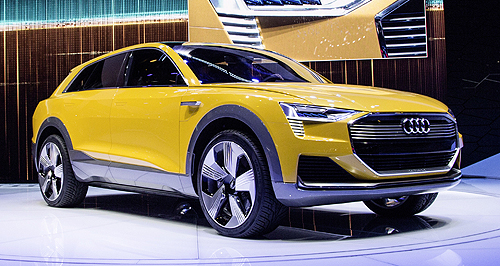News - AudiAudi and Hyundai team up for FCEV techHail, hydro: Fuel-cell electric vehicles, such as the Hyundai Nexo (left) and Audi h-tron concept (below), convert hydrogen and oxygen into electricity for emissions-free driving and take minutes to refuel. Hydrogen fuel-cell electric vehicle parts to be shared between Audi and Hyundai22 Jun 2018 By TUNG NGUYEN AUDI AG and Hyundai Motor Company have announced an alliance to propel the development and mass-market adoption of hydrogen fuel-cell electric vehicles (FCEV), with both brands launching emissions-free SUVs at the turn of the next decade.
While Hyundai has been busy on its Nexo crossover, which was revealed last August and christened earlier this year at the Consumer Electronics Show (CES), Audi is yet to show its FCEV hand but promises “a sporty SUV” that “will combine the premium comfort of the full-size segment with long-range capability”.
Ingolstadt’s first production FCEV will be limited in number however,and is likely to be an evolution of the h-tron quattro concept revealed at last year’s Detroit motor show.
As such, the production version could look similar to the incoming e-tron battery electric SUV set to hit Australian showrooms next year.
Although it is unclear whether Audi’s yet-to-be-named hydrogen model is too far along in development to take advantage of the new partnership, the German car-maker will be given access to Hyundai’s FCEV parts supply chain, as well as components used in the ix35 Fuel Cell and Nexo SUVs.
Both brands will share patents and have access to each other’s non-competitive FCEV parts going forward and are “already focused on the next development stage intended for a broader market offer,” according to Audi.
The collaboration will also see affiliated brands, such as Kia Motors Corporation and other Volkswagen Group marques, granted access to the shared FCEV technologies, while the length of the tie-up has not yet been divulged.
Hyundai’s Nexo sports a 120kW/394Nm powertrain that enables a zero-to-100km/h acceleration time of 9.5 seconds and claimed driving range of 800km.
Although not yet confirmed for mass-market sale in Australia, the ACT government will take delivery of a small fleet of 20 Nexo vehicles next year.
FCEVs use hydrogen and oxygen to generate electricity to power the motor, emitting only water and heat, but a lack of local hydrogen refuelling stations has been cited as a barrier to bringing FCEVs to Australia.
However, Hyundai has built its own station at its headquarters in Sydney to top-up vehicles, while Toyota Australia has developed its own mobile hydrogen refuelling station for its small fleet of Mirai sedans in the country to gauge interest.
As emissions regulations become stricter, Audi AG board member for technical development Peter Mertens said hydrogen technology presents a unique powertrain opportunity.
“The fuel cell is the most systematic form of electric driving and thus a potent asset in our technology portfolio for the emission-free premium mobility of the future,” he said.
Meanwhile, Hyundai Motor Company vice chairman Euisun Chung said he hopes the alliance with Audi will bring more FCEVs to market.
“We are confident that our partnership with Audi will successfully demonstrate the vision and benefits of FCEVs to the global society,” he said.
“This agreement is another example of Hyundai’s strong commitment to creating a more sustainable future whilst enhancing consumers’ lives with hydrogen-powered vehicles, the fastest way to a truly zero-emission world.”  Read more |
Click to shareAudi articlesResearch Audi Motor industry news |

















Facebook Twitter Instagram